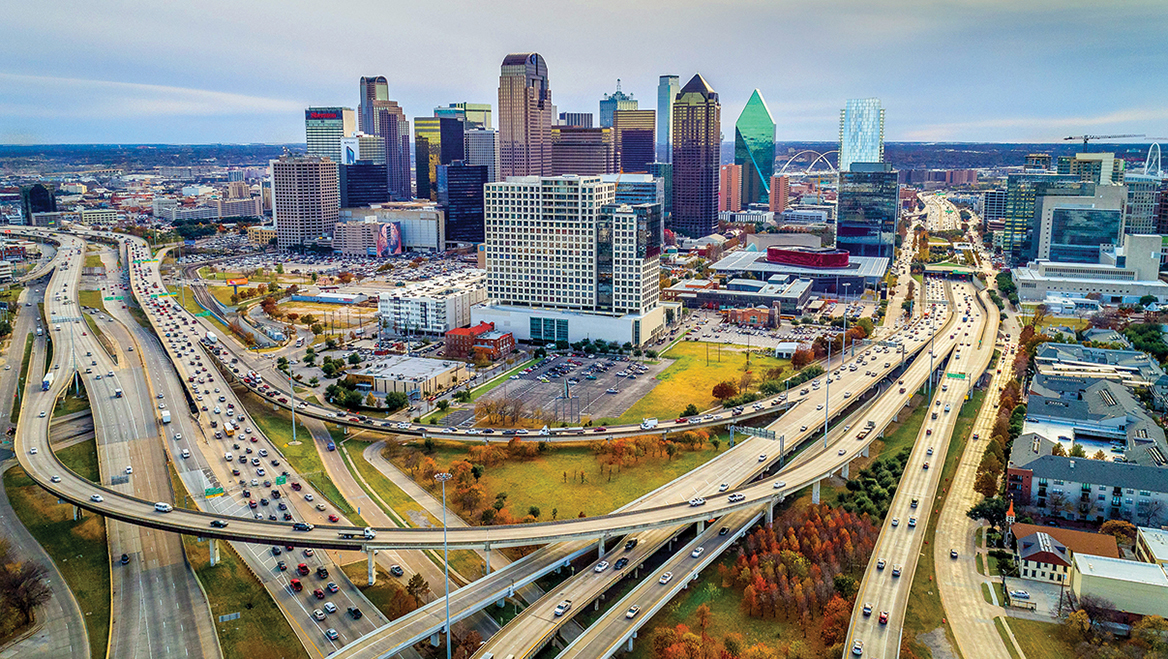Sept. 19, 2022
Imagine: It's 2050, and most of America's interstate highways have disappeared from central business districts. Tree-lined boulevards and transit lines have replaced highway infrastructure, and the attendant noise, traffic, and air pollution have decreased. Once-isolated homes and businesses are connected to healthy, active corridors that help local economies thrive.
That's the future many placemaking experts are working toward, backed by new tools and funding resources from the U.S. Department of Transportation (USDOT).
USDOT is charged with administering transportation programs from the $1 trillion Bipartisan Infrastructure Law passed by Congress in November 2021. Part of that law, the Reconnecting Communities Pilot Program, is being hailed as a transformative grant opportunity to directly rectify harm caused by highway construction.
From 1956 through the two decades that followed, construction of the U.S. interstate highway system displaced over a million people, according to the USDOT report Beyond Traffic: 2045.
"The interstate highway system promoted the development of suburban communities, which in many cases actively excluded people of color, facilitating white flight, reinforcing and increasing de facto racial segregation, and undermining the tax base of many urban communities and the ridership and profitability of regional transit systems," the report says.
"In many cases, interstate routes were chosen based on areas where land costs were the lowest or where political resistance was weakes," it continues. "In practice, this meant that urban interstates cut through low-income and minority communities more often than not."
Last year, current USDOT Secretary Pete Buttigieg further acknowledged this legacy, calling the design of U.S. highways "racist," and said that would be the focus of the legislation. Many cities have welcomed the shift toward accountability.
Addie Weber, AICP, Toole Design Group's Atlanta office director, says the construction of I-345 has dramatically impacted Dallas.
"At the very local level, the highway and its interchanges have generated significant noise and light pollution; severely limited opportunities for walking, biking, transit, and local car access by destroying the block structure; and created an ugly, blighted landscape that depressed land values." Toole Design Group has partnered with the Coalition for a New Dallas to reimagine I-345, a 1.4-mile elevated freeway reaching the end of its lifespan.
Through the Reconnecting Communities Pilot Program, the USDOT will allocate at least $1 billion over a five-year period to help more places address transportation facilities like highways that continue to create barriers to connectivity, cause health issues like asthma, and stunt economic development. (While the deadline for the pilot's cycle has passed, there will be four other opportunities to submit an application.)
A move toward justice
In Buffalo, New York, residents are ready to see Kensington Expressway returned to what it once was. Constructed in the mid-1900s, it replaced a grand, tree-lined boulevard — historic Humboldt Parkway, designed by Frederick Law Olmsted — with a below-grade highway that divided the surrounding neighborhoods. This new program could make it a verdant, vital artery once more, says community leader and activist Stephanie Barber-Geter, the chairperson of the Restore Our Community Coalition, a nonprofit specifically dedicated to remediating the devastation and civic injustice created by the highway.
"We will apply for for the planning grant, in partnership with the mayor of Buffalo, to further engage the community throughout the project's next steps," she says. Public engagement is an eligible activity for the planning grant. New York Governor Kathy Hochul has also committed $1 billion to the effort.
"We'd ultimately like to have a tree-lined boulevard on grade level and vehicular traffic below grade," Barber-Geter says. "Our Black residents that were here for more than 50 years want the Humboldt Parkway back to what it was."

I-345 has created pollution and depressed land values in Dallas, critics say. As the highway reaches the end of its lifespan, the city solicited resident input this year for a new plan. Photo by Brian Hellemn/iStock/Getty Images Plus.
Rico Quirindongo, AIA, the acting director for Seatle's Office of Planning and Community Development, sees the funding opportunity as a way to address a variety of local issues.
"Reconnect South Park is a community-led initiative aiming to address the many harms caused by [highway] SR-99 and create more opportunities for South Park residents," he says. "If the highway were removed, it would free up 40 acres of much-needed land for affordable housing, grid reconnection, green space, small businesses, and other community-supportive uses."
Quirindongo also sees this program as support for climate action. The grant can be used for environmental studies, public transportation, pedestrian walkways and overpasses, linear parks and trails, capping and lids (a type of deck bridge over a highway that can be turned into green space), and other planning, technical, and capital construction activities.
"Removal and capping/lidding strategies can create more land available for housing, green space, and economic activity," he says. "As we enter ever deeper into a climate crisis, it is more critical than ever that we work to create urban environments where it is easy and pleasant to walk, bike, stroll, or take public transportation."
Challenges remain
Could Reconnecting Communities really make a difference?
"Yes. We believe the USDOT genuinely sees the Reconnecting Communities program as a way to begin to repair the damage done to Black and brown communities by transportation projects, policies, and programs," says Andrea Ostrodka, AICP, Toole Design Group's transit practice lead and Central Florida office director.
Reconnecting Communities could help move us in the right direction, says Quirindongo, but the scale of funding does not yet match the need. As it now stands, the pilot program is meant to supplement funding from larger sources, like the Federal Highway Administration's National Highway Performance Program.
Another challenge is ensuring that the pilot and broader infrastructure law do not fund the same inequities it aims to undo, like "new and expanded roadways, bigger intersections, and projects that continue down the wrong path," Ostrodka warns. Planners and other place makers will be instrumental in ensuring their correct application.




